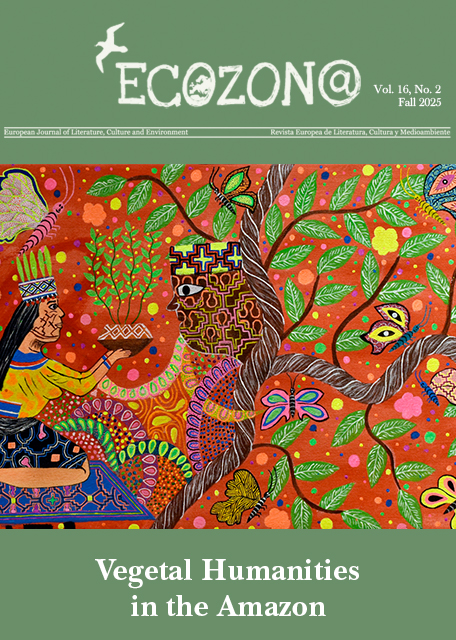<b>Cosmovisiones amazónicas</b> // Amazonian Cosmovisions
DOI:
https://doi.org/10.37536/ECOZONA.2017.8.1.1373Resumen
Resumen
En el cuadro “La primera chacra”, a través de una paleta vibrante de colores contrastantes y delicados trazos sobre un fondo monocromático oscuro, Yahuarcani representa el lugar donde las plantas son cultivadas, un espacio lleno de vida y espíritus. Según el conocimiento Amazónico, las plantas tienen distintos espíritus que pueden influenciar el mundo material y los cuerpos humanos, y pueden comunicarse con la gente. Esta perspectiva de la naturaleza cuestiona el punto de vista moderno occidental sobre el cultivo de plantas y el lugar de ellas en la sociedad. Pero “La primera chacra” no es una representación del entorno natural, ni una descripción visual de temas mitológicos. Por el contrario, Yahuarcani pinta un concepto más abstracto: una fuerza natural, productora de vida, un dominio donde lo espiritual y lo material están interconectados.
En “La primera chacra”, así como en las pinturas “El río” o “Al caer la noche”, el entorno Amazónico no es explícito. Yahuarcani se inspira en el conocimiento y mitos de la Amazonía para producir un trabajo evocativo sobre ella. A través de pinturas en las que el tratamiento estético de las imágenes predomina sobre la narrativa, Yahuarcani da nueva forma al conocimiento ancestral amazónico, reivindicando su importancia y validez en el mundo contemporáneo.
Abstract
In the first painting “La primera chacra” (The First Little Farm), through a very vibrant palette of contrasting colors and delicate traces over a monochrome dark background, Yahuarcani depicts the place where plants are cultivated, a space full of life and of spirits. According to the Amazonian knowledge, plants have distinct spirits that are able to influence the material world and human bodies, and can communicate with people. This perspective on nature questions modern Western views on farming and the place of plants in society. But “The First Little Farm” is not a depiction of the natural environment, neither a visual description of mythological subjects. Rather, Yahuarcani paints a more abstract concept of it: a natural force, producer of life, a domain where the spiritual and the material are interconnected.
In “The First Little Farm” as well as the paintings El río (River) or Al caer la noche (Nightfall), the Amazonian environment is not explicit. Yahuarcani is inspired by the knowledge and myths of the Amazon to produce a work evocative of the Amazonia in his own language. Through paintings in which the aesthetic treatment of the images predominates over the narrative, Yahuarcani reshape the ancient Amazonian knowledge, reassessing his importance and validity in the contemporary world.
References
Borea, Giuliana. “Personal cartographies of a Huitoto mythology: Rember Yahuarcani and the enlarging of the Peruvian contemporary art scene.” Revista de Antropologia Social dos Alunos do PPGAS-UFSCar 2, n. 2 (Jul.-Dec. 2010): 67-87.
Yahuarcani, Rember. “Los ríos de nuestra memoria.” Mundo Amazónico 5 (2014): 197-209.
Yllia Miranda, María Eugenia. “Antropófagos contemporáneos: paradojas y lógicas visuales en la pintura amazónica contemporánea peruana.” Actas del Seminario Internacional Estudios y Encuentros entre Antropología y Arte. Lima: PUCP, en prensa.
Descargas
Descargas
Publicado
Número
Sección
Licencia
Authors who publish with this journal agree to the following terms:
a) Authors retain copyright and grant the journal right of first publication with the work simultaneously licensed under a Creative Commons Attribution License that allows others to share the work with an acknowledgement of the work's authorship and initial publication in this journal (CC BY-NC for articles and CC BY-NC-ND for creative work, unless author requests otherwise.
b) Authors are able to enter into separate, additional contractual arrangements for the non-exclusive distribution of the journal's published version of the work (e.g., post it to an institutional repository or publish it in a book), with an acknowledgement of its initial publication in this journal.
c) Authors are permitted and encouraged to post their work online (e.g., in institutional repositories or on their website) prior to and during the submission process, as it can lead to productive exchanges, as well as earlier and greater citation of published work (See The Effect of Open Access).










